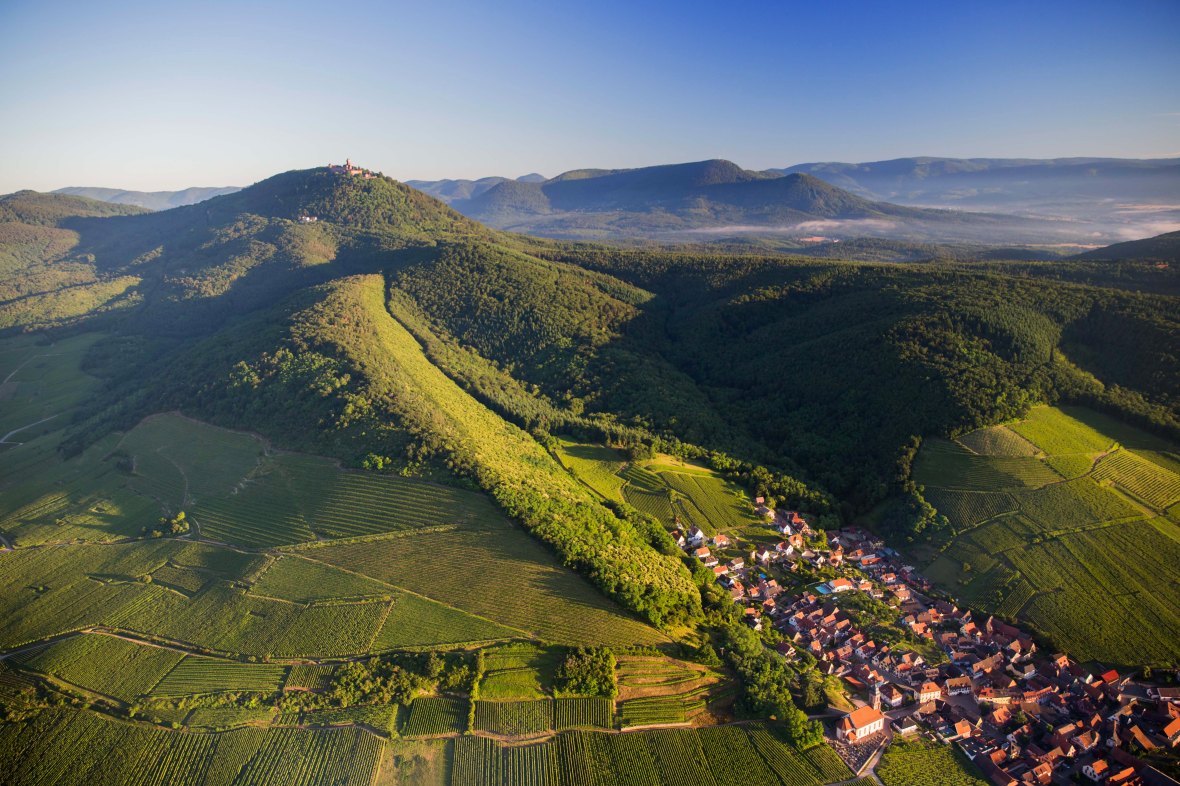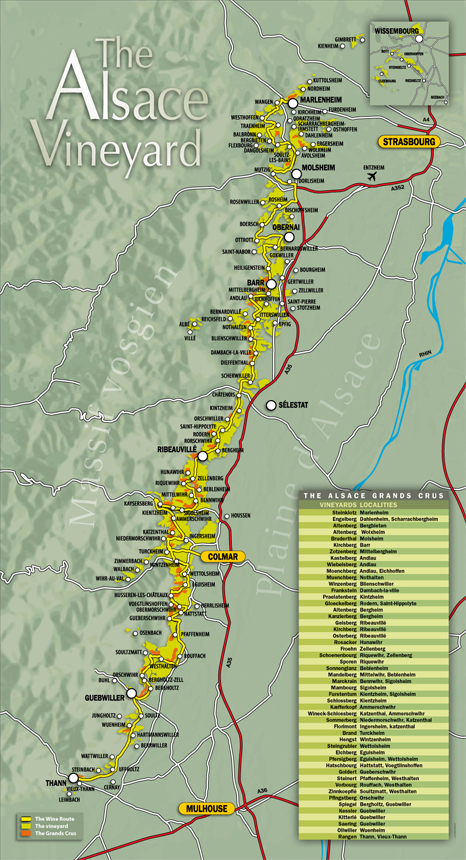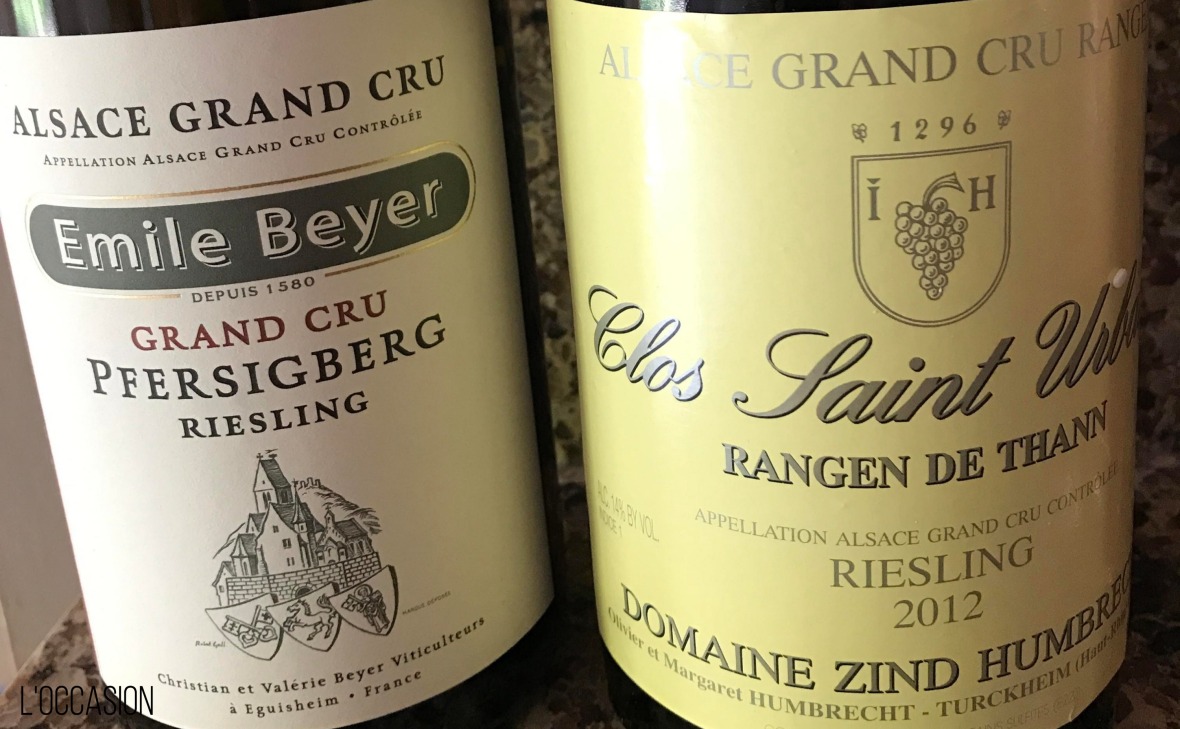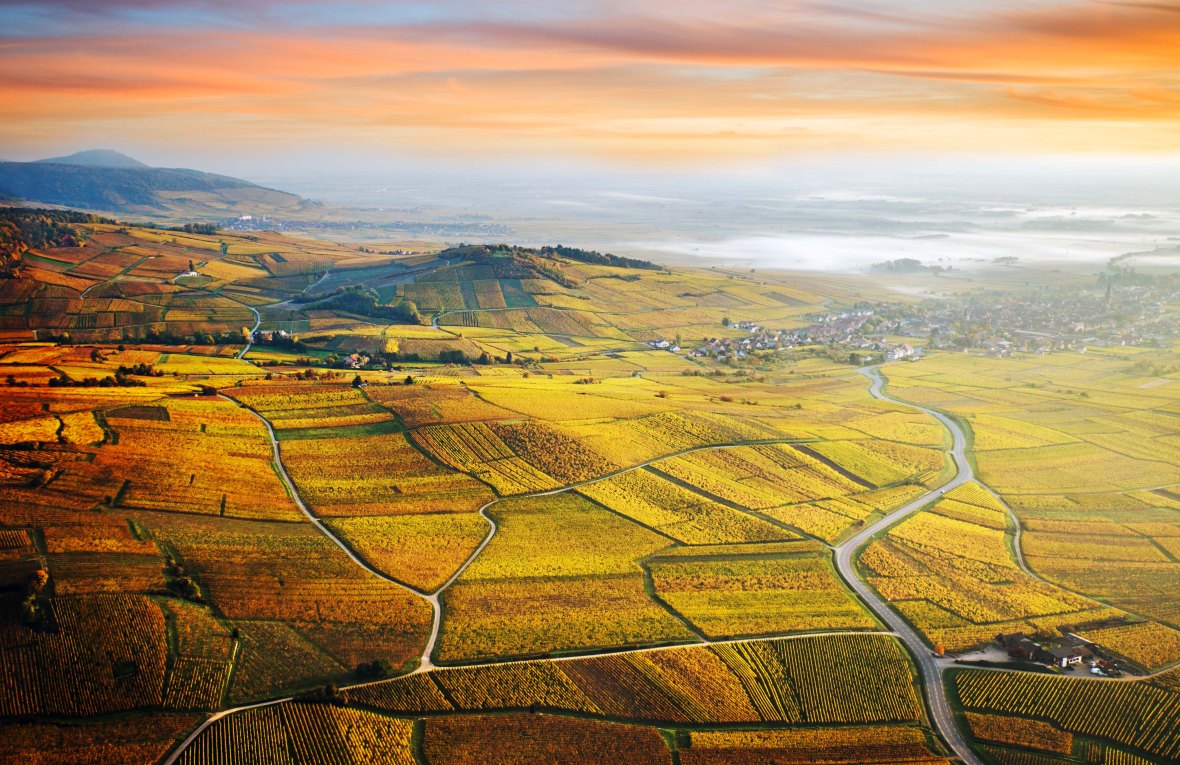
Views and vineyards of Alsace. Courtesy: Wines of Alsace
Exploring terroir can be a bit of a mystery — what can we experience of place in a sip of wine? Because we are all unique and our senses explore the world based on our own personal motherboard of programming, there isn’t a definition of terroir’s translation to taste. That’s a good thing, but curious minds relish the chance to test and explore and this month I got an irresistible opportunity to examine Alsatian Riesling from four soils — the same variety and the same slice of the world, but different land composition.
A Bit On Alsace
Alsace is located in the northeast corner of France and threads along the Rhine river. The Route des Vins d’Alsace leads wine lovers through over 100 villages frosted with charming timber homes and buildings. The Vosges Mountains create an additional layer of appeal: beautiful, rolling, natural. Cobblestones, flowers, estates, history (a load of history) are all part of the Alsace experience. Alsace is not far from the Champagne region, but the atmosphere is quite different, with the influence of the Vosges range as well as more sunny warmth. A rarity in France, Alsace wines are labeled not only by place but also by variety and there are 51 Grand Cru sites in the region.

Alsace vineyard map. Courtesy: Wines of Alsace
Four Wines From Four Soils
2012 Zind-Humbrecht Riesling Rangen de Thann: Domaine Zind-Humbrecht dates back to 1620 and is now managed by Olivier Humbrecht, winemaker and Master of Wine, a rare combination. Humbrecht works in biodynamics and this wine originates from Clos-Saint-Urbain in the Rangen Grand Cru vineyard on volcanic soil.
What does volcanic soil contribute to classic Alsatian Riesling? Ember and stone come through on the nose with a balance of weight and depth. Winemaking contributes body, which Zind-Humbrecht explains as “extended pressing, abbreviated clarification cycles (to retain natural yeasts and proteins in the must), natural malo-lactic fermentation and extended aging on the lees. The wine is aged 18 months in 40-year-old French barrels”. $75 suggested retail price.

Two Rieslings from Alsace — nuanced soil, nuanced terroir. Credit: Jill Barth
2016 Emile Beyer Riesling Grand Cru Pfersigberg: A mantra for Alsace, Emile Beyer goes back generations. Situated in Eguisheim, outside of Colmar, this location is iconic as it gets. From Grand Cru Pfersigberg, a 185-acre vineyard, this wine comes from limestone soils mixed with sandstone and experiences the effects of the Vosges range as warmth. All grapes are hand-harvested from small parcels.
What does limestone soil contribute to Alsatian Riesling? Rich, warm orange orchard flavors and an intensity in youth that benefits from a round of decanting. Beyer’s winemaking is, of course, experienced and skilled. Of technique the winery shares, “once harvested, the grapes go through a gentle and slow pressing and a cool, long fermentation in tank. Aging is completed in a combination of used barrels and tank”. $44 suggested retail price.
2016 Weinbach Riesling GC Schlossberg: You guessed it — Weinbach dates back to the 1600’s, founded by Capuchin monks. Certified organic and biodynamic granite vineyards in Grand Cru Schlossberg are so steep that they must be terraced.
What does granite soil contribute to Alsatian Riesling? Tropical aromatics, as well as pineapple on the palate, are matched with acidic freshness. Catherine Faller and her son Théo are proprietors, employing a light touch on this precious fruit. Of their winemaking they share, “the grapes are gently and very slowly pressed, and the wines are vinified in ancient casks. Only native yeasts are used for fermentation, and there is minimal intervention but constant attention.” $40 suggested retail price.

Grand Cru Riesling, side by side terroir comparison. Credit: Jill Barth
2013 Charles Baur Riesling Grand Cru Eichberg: 42 acres near Eguisheim, the Grand Cru Eichberg has south-east exposure and restricted rainfall. With 18th century roots, this is another Alsatian classic domaine producing this wine from marl-limestone soil.
What does marl-limestone soil contribute to Alsatian Riesling? Perhaps marl is a new-to-you-term, less commonly conversational than the other types of soil. Marl contains clay and silt and is calcium- and lime-rich. In this wine, it displays as youthful yellow flavors of citrus and banana, with balanced acid. Proprietor Arnaud Baur uses techniques described by the domaine as, “extraction through pneumatic pressure of whole grapes, slow fermentation under close temperature regulation. Maturation on fine lees takes place for a nine-month period after which time the wine is bottled.” $25 suggested retail price.

Route des Vins d’Alsace. Courtesy: Wines of Alsace
The French Winophiles
Please join our Frech Winophiles #AlsaceRocks twitter chat. We love visitors and happily chat and answer questions. Simply tune in to the #winophiles hashtag on Twitter this Saturday, June 16 at 10am CDT. You can also check out the #AlsaceRocks hashtag for more Alsace fun during and after the chat.
Here’s a list of great Alsace wine suggestions from our Winophiles
Robin at Crushed Grape Chronicles shares “A Palette of Pinots – The Hues of Alsace”
Martin at Enofylz Wine Blog shares “Pinot d’Alsace…Yes Please!”
Rupal at Syrah Queen shares “Rockin Alsace With Pinots”
Julia at Julia Coney shares “Alsace – Where Pinot Rocks!“
Wendy at A Day in the Life on the Farm shares “Alsace Rocks the Summer Grilling Scene”
Jeff (our co-host this month) at Food Wine Click! shares “Alsace Wines in the American Kitchen”
Lauren at The Swirling Dervish shares “Alsatian Temptation: Wine from the Vosges Mountains in France“
Jane at Always Ravenous shares “Tips and Recipes for Alsace Pairings”
Camilla at Culinary Adventures with Camilla shares “Alsace Pairing Challenge? Accepted!”
Olivier at In Taste Buds We Trust shares “Taking gewürztraminer to a higher level”
Michelle at Rockin Red Blog shares “Getting Dirty with Alsace Riesling“
Payal at Keep the Peas shares “Alsace: A Geologist’s Dream”
Jill at L’Occasion shares “A Riesling Experience: Nuanced Terroirs of Alsace” (thanks for reading)
Liz at What’s in that Bottle shares “All in for Alsace Riesling”
David at Cooking Chat shares “Pork and Cabbage Skillet with Riesling from Alsace”
Gwen at Wine Predator shares “Alsace Rocks 4 Riesling With Fondue!”
Nicole at Somm’s Table shares “Alsace-a-palooza Part 1: The Wines”
Some wines featured on L’Occasion are media samples. All opinions and editorial decisions are my own.

Nice discussion of the soil! Have to say I’ve not decanted a white nor been at a tasting when one was decanted. But I can see, how it it could open up a Riesling that poured out a little tight or show more dimensionality in a super crisp wine.
LikeLike
I spent the evening sipping and time did unfold this one z
LikeLike
What a line up! I visited a couple of these grand crus and they are incredible to see. I also had dinner the Arnaud Baur on Tuesday night. His wines are outstanding. Thanks for breaking it all down.
LikeLiked by 1 person
It’s so valuable to have the onsite experience!
LikeLiked by 1 person
Thanks for the virtual seminar on Alsace Riesling! The wines sound first-rate, and the ability to taste them together was probably enlightening and enjoyable. There’s so much to discover in this region, isn’t there?
LikeLike
Very awesome experience! Thank you!
LikeLiked by 1 person
Great post, Jill. I received the same sample bottles and was wowed by them all. Really fun to taste through wines from varied soil types.
LikeLike
It was a gem of a lineup!
LikeLike
Isn’t it amazing how much the soil has to do with the final product? Very informative article. Thanks for sharing.
LikeLike
Fascinating topic!
LikeLike
I love the soil influence on the end product. I’ve never been able to go the other way though, to identify the soil a wine was grown in based on the flavors in the wine. More tasting required!
LikeLike
More tasting is key!
LikeLike
I have always been fascinated with soils and how they can affect wine. This has really left me wanting to dive deeply into the subject.
LikeLike
It is a meaningful topic – love learning through Reisling!
LikeLike
A really wonderful description and exploration of the terroir!
LikeLike
Thanks Nicole!
LikeLike